

Focus 2 Achieve - How To Make Reading Less Boring And More Edji. Hey, Guess what?
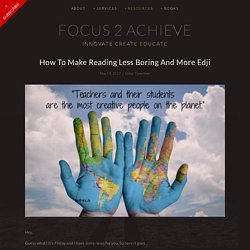
It's Friday and I have some news for you. So here it goes... Whether you like it or not, you are tasked with teaching reading. No matter what subject you teach, your students must be able to interpret text and extract meaning from it. Having said that, let me also mention that as a science teacher, I do not teach reading enough. As I think about it, I am realizing this is precisely the reason I should do it more often. So, I have done some article lesson plans. But most of the time, my students probably die a little inside or at least throw up in their mouths a bit, when asked to read a piece they just don't give 2 fecal matter units about. Did he just misspell edgy? Uhm... Building Choice Into Your Students’ Reading. As more and more teachers are building choice reading time into their daily classroom schedules, making a variety of books available to a diverse group of students can be challenging.
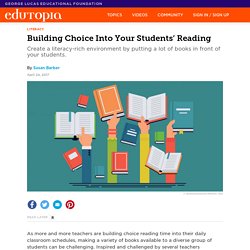
Inspired and challenged by several teachers (including Brian Sztabnik—see “Igniting a Passion for Reading”) to incorporate daily independent reading into class, I have set aside 15 minutes in each 90 minutes block for independent choice reading. After making the jump, I quickly realized that I needed a way to keep a variety of books for selection in front of my students. The Perfect Package: Creating a Language-Rich Text Set. This article on creating a balanced literacy text set is Part 16 of WIDA’s Essential Actions Series.
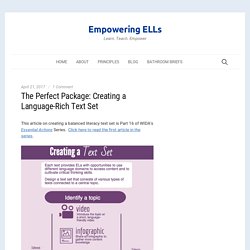
Click here to read the first article in the series. I remember being issued a massive textbook for every class in high school. That massive textbook was our entire text set. We often started the year on the first page, and, as the year progressed, we moved through the book with increasing speed to cover the material. The resources and texts used by teachers are like ingredients in a kitchen for chefs. Action 13 found in WIDA’s Essential Actions: A Handbook for Implementing WIDA’s Framework for English Language Development Standards (Gottlieb, 2013) encourages teachers to integrate language domains – reading, writing, speaking, listening, and visually creating – to ensure that ELs learn content while growing their language skills.
This requires the use of a text set, defined as a collection of readings, images, and videos connected to a single topic. DOK 2 Vocabulary Activity - Teacher Tech. Depth of Knowledge (DOK) is about the complexity of thinking the student is doing.
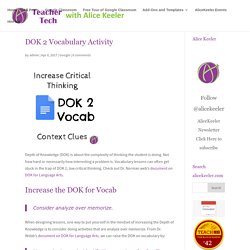
Not how hard or necessarily how interesting a problem is. Vocabulary lessons can often get stuck in the trap of DOK 1, low critical thinking. Check out Dr. Norman web’s document on DOK for Language Arts. Consider analyze over memorize. When designing lessons, one way to put yourself in the mindset of increasing the Depth of Knowledge is to consider doing activities that are analyze over memorize. Use context cues to identify the meaning of unfamiliar words. PDF to Google Doc I am a fan of Google Docs. Warning, if your PDF has some fancy layouts and formatting this probably won’t be the best conversion. Sample Assignment DOK 2 – Context Clues In Google Classroom, click on OPEN and find your copy of the reading passage Read through the passage. After identifying the vocab words and trying to figure them out with context clues, share the Google Doc with a partner.
Control Alt M Conversations Compare Comments Button. 25 Reading Strategies That Work In Every Content Area. 25 Reading Strategies That Work In Every Content Area Reading is reading.
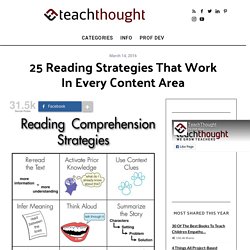
By understanding that letters make sounds, we can blend those sounds together to make whole sounds that symbolize meaning we can all exchange with one another. Without getting too Platonic about it all, reading doesn’t change simply because you’re reading a text from another content area. Only sometimes it does. Science content can often by full of jargon, research citations, and odd text features. Social Studies content can be an interesting mix of itemized information, and traditional paragraphs/imagery. Literature? What Doesn't Work: Literacy Practices We Should Abandon. The number one concern that I hear from educators is lack of time, particularly lack of instructional time with students.
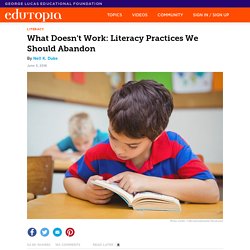
It's not surprising that we feel a press for time. Our expectations for students have increased dramatically, but our actual class time with students has not. Although we can't entirely solve the time problem, we can mitigate it by carefully analyzing our use of class time, looking for what Beth Brinkerhoff and Alysia Roehrig (2014) call "time wasters. " 6 Techniques for Building Reading Skills—in Any Subject.
As avid lovers of literature, teachers often find themselves wanting to impart every bit of knowledge about a well-loved text to their students.
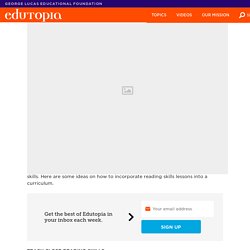
And this is not just an ELA issue—other disciplines also often focus on the content of a text. However, teaching reading skills in English classes and across the disciplines is an almost guaranteed way to help students retain content. Unfortunately, the tendency to focus on the content is a real enemy to the ultimate goal of building reading skills.